Aquarium

Gem tang, Zebrasoma gemmatum
Many of the 80 or so members of the tang and surgeonfish family have wide ranges across tropical seas, but this uniquely spotted species is restricted to Madagascar, the nearby East African Coast, and the Mascarene Islands. As few fishes are exported from these places, it has seldom been seen in public aquariums.
LEARN MORE
Eschmeyer’s scorpionfish, Rhinopias eschmeyeri
Scorpionfish, in general, are notorious for the venomous spines which give them their family name. The six members of the genus Rhinopias stand out for their magnificently bizarre appearance. Their story-book dragon faces, ornate fins, and peculiar under-water waddle, make them fascinating. This species, from the Indian Ocean and Indo-Pacific, was unknown to science until 1977, when it was named to honor the American authority on scorpionfish, who described two other new Rhinopias species in 1973.
LEARN MORE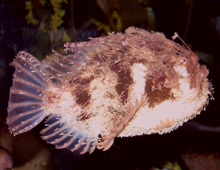
Tasseled anglerfish, Rhycherus filamentosus
This specialized fish, also known as a frogfish, is found only in Southern Australia and is seldom displayed in aquariums. They have the ability to walk under water by using their uniquely modified pelvic and pectoral fins. Anglerfish were named for the modification of their dorsal fin that functions as a fishing rod and lure. Unsuspecting prey attracted by the moving “lure” are seized in the enormous mouth.
LEARN MORE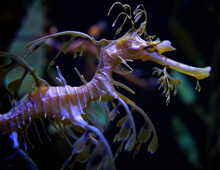
Leafy seadragon, Phycodurus eques
The DWA was one of the first facilities in the US to successfully maintain and display these beautifully ornate relatives of the seahorse. Due to their specialized dietary and habitat requirements, this species has not reproduced successfully in an aquarium environment. The DWA is an industry leader in the husbandry of this species and hopes to help find the key to their reproduction in the future. Leafy and Weedy seadragons are strictly protected and export is carefully regulated.
LEARN MORE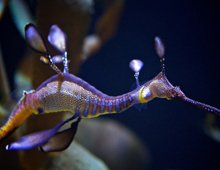
Weedy seadragon, Phyllopteryx taeniolatus
Like its better-known relative, the Leafy seadragon, the Weedy seadragon is considered a highly specialized pipefish, rather than a true seahorse. The males of all pipefishes and seahorses receive the eggs from the female after they are laid and brood them until they hatch. Unlike male seahorses who store eggs in a brood pouch, seadragons attach eggs to a brood patch. The Weedy seadragon is the Marine Emblem of the Australian State of Victoria while the “Leafy” is the Marine Emblem for South Australia.
LEARN MORE
Watanabe’s angelfish, Genicanthus watanabei
The ten species of swallowtail angelfish stand out among the marine angelfish family. Instead of staying close to the reef, and feeding on coral polyps and other stationary organisms, swallowtails consume plankton in the water column. While the sexes of other angelfishes are colored alike, male and female swallowtails look very different from each other. Only described to science in 1970, this species occurs off Japan and Australia, and far out into the Central Pacific, but is absent from the Indo-Pacific. Only the male has stripes.
LEARN MORE
Starki damselfish, Chrysiptera starcki
Also known as the Starck’s demoiselle, the Starki damsel, is found in the northern and southern parts of the West Pacific. These brightly colored reef dwellers are commonly kept in aquariums and are extremely hardy fish. Like other members of the family Pomacentridae, they can be very territorial, despite their small size. They can be seen fiercely defending a crevice, or hiding quietly under a coral or clam.
LEARN MORE
Carpet anemone, Stichodactyla mertensii
The Carpet anemone is named for its large size which resembles a carpet. The short tentacles have the appearance of the “pile” of a carpet, and have powerful stinging nematocysts. Many Carpet anemones serve as symbiotic hosts to clownfish who can hide within the anemone without being stung. Some Carpet anemones can grow to more than three feet in diameter.
LEARN MORE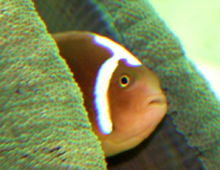
White-capped clownfish, Amphiprion leucokranos
The White-capped clownfish is named for the white color mark on its forehead. The name “leucokranos” is derived from the Greek word meaning “white capped” or “white helmet”. It was discovered in 1972 in Mandang, New Guinea. As is the case in our Solomon Islands exhibit, the White capped clownfish is often associated with the Carpet anemone, Stichodactyla sp., and rarely strays far from the protection of its stinging tentacles. A thick mucous coating on its skin keeps the clownfish from being stung.
LEARN MORE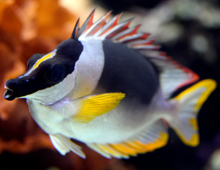
Magnificent foxface, Siganus magnificus
The Magnificent foxface is often considered the most attractive member of the Rabbitfish family. They are herbivorous in nature and can be seen grazing on algae throughout the day. Venomous dorsal spines and the ability to change color rapidly, help defend this coral reef dweller from predators.
LEARN MORE

